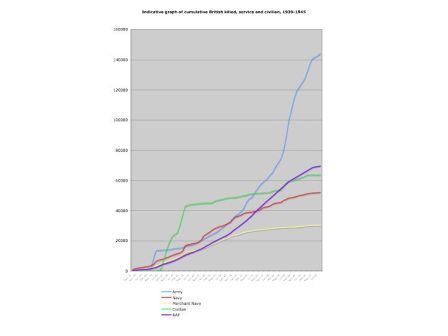After a fair share of swearing, toil, tears and sweat, I’ve come up with a first attempt at a graph representing the numbers of Britons killed during the Second World War. As I’ll explain, this has involved a fair amount of fudging and compromise, and I would not claim that what I’ve produced is perfect, but I still think the project is worthwhile and I’ll also give some examples of how I think it’s been useful.
Merchant Navy deaths
March 18, 2008This is part of an ongoing series of posts on trying to draw a graph showing British service and civilian losses in the Second World War.
Some of the hardest casualty figures to get hold of are those relating to the Merchant Navy. As I’ve described before, the Royal Navy doesn’t seem to have kept a running total of the dead and wounded in the way the RAF did: probably because it the number and class of ships sunk that was most important in terms of whether it could sustain its war effort. For the Merchant Navy, that was also a consideration, but the situation was further complicated by the range of different ships and different seamen, of different nationalities, who saw action. Three knowledgeable maritime historians whose judgements I trust have told me that they think there’s no way to get hold of detailed month by month figures for the Merchant Navy. So how to get round this if you believe, as I do, that Britain’s ability to access resources from around the globe needs to be written into the ‘grand narrative’ of the Second World War, and you want to include Merchant Navy losses in the graph of wartime deaths?
Navy dead
March 10, 2008Continuing the work on Second World War casualties, this graph shows month by month deaths of British and colonial servicemen in the Royal Navy.
I’ve drawn the data for this, with permission, from Don Kindell’s excellent work at naval-history.net.




 Posted by trenchfever
Posted by trenchfever 
